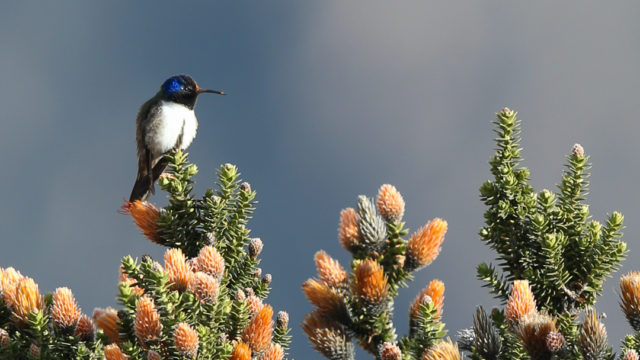An alien circling high above our planet will see that the highest mountain on Earth is in Ecuador. The reason for this is that Mount Chimborazo stands on the widest part of the Earth, the equator.
When Alexander von Humboldt measured Chimborazo in 1801 he thought it was the highest mountain, so in true Humboldt style he tried to reach the summit. At 5,800m (19,000 ft) all his indian guides had deserted him and he himself had bleeding gums and was gasping for every small breath he could manage.
Humboldt is one of the greatest naturalists of all time and father of Biogeography. He was the first and greatest explorer of South America, a man whose writings encouraged Darwin to follow in his footsteps,
…. and, by the way, more places on earth have been named after this man than anyone else!
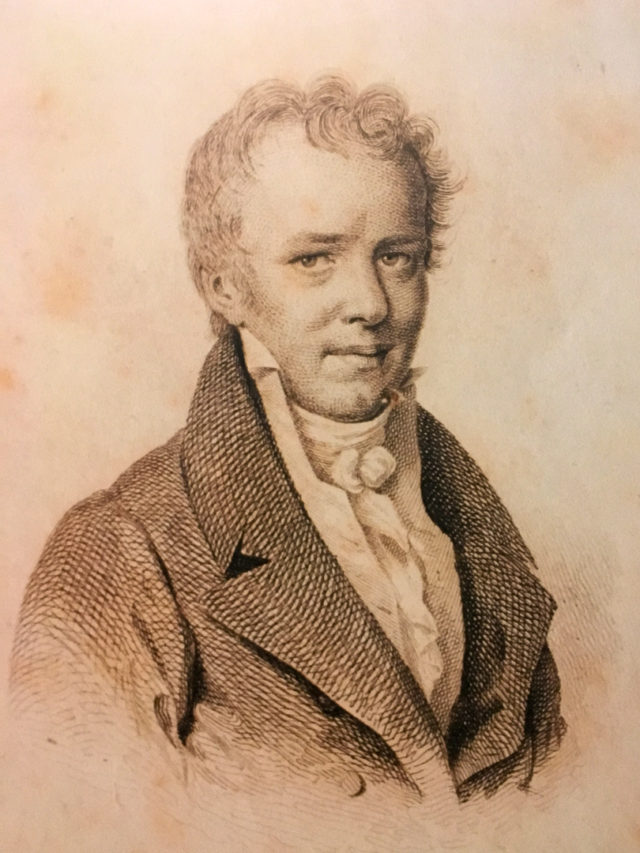
Our exploration of Chimborazo was far less exciting, hardly noticable in any way at all. But this mountain, or should I say Volcano, has left a lasting impact on us.
What drew us to Chimborazo in the first place was a hummingbird, the Chimborazo Hillstar, that lives on its volcanic slopes.
We crossed over the border from Peru and headed as directly as we could towards the volcano. With ever more sinking hearts, the twisting roads led us hour after hour through a highly agricultural mountain realm. Our imagination of what to expect in Ecuador had led us into a world of fantasy. We were expecting Ecuador to be wild and forested, it is not. This is a landscape that has been tamed by man for hundreds and hundreds of years. The majority of the forests have gone, the mountainous slopes turned into a tumbling of neatly kept tilled terraces. The growing of potatoes, maize, carrots and beans being the mainstay of the local economy.
Even in Ecuador, wildlife has to find hidden corners to survive.
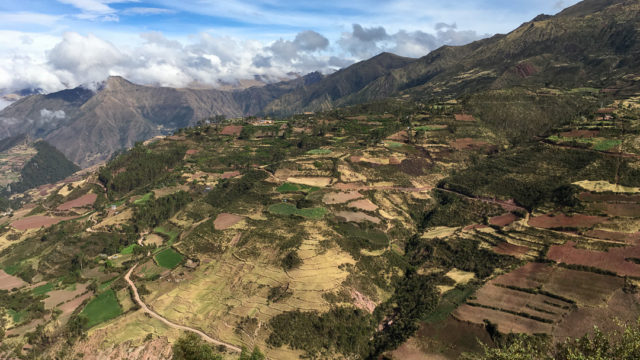
Driving up one set of hairpin bends we eventually straightened out onto a plateau and beyond, perhaps thirty miles away, stood a most beautiful sight, an ‘ice cream’ shaped dome of a mountain, Chimborazo.
Several hours later we arrived at the National Park road which led to the entrance gate. It was late afternoon so decided to park close by and drive further on the following morning. Our camp that night was at 4,150m (13,500ft). This is 3,000 ft higher than Hannibal had taken his troops over the Pyrenees, to smash the Roman army, a high altitude endeavour that cost the lives of 30,000 of his troops.
We had a shocking night, our sleep being fitful as the temperature inside our sleeping compartment dropped well below zero, we were even too cold to retreive the oxygen from our driving cab. For the second time in a day, our imagination of being on the equator, in Ecuador, the land of flowers and exotic fruits had played games with us. Chimborazo had caught us unawares.
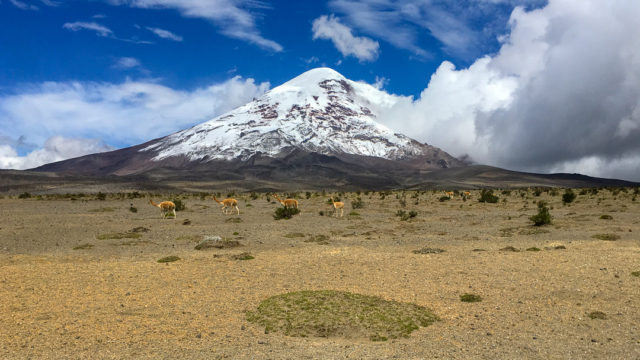
In the morning the ground outside glistened with frost. Our aim to be out before dawn being a ditched romantic dream. We huddled inside and ate hot porridge, retrieved the oxygen and went back to bed. When I did stagger outside, our first and, to date, our only Carunculated Caracara stood close by looking at me, a look of wonder on its face.
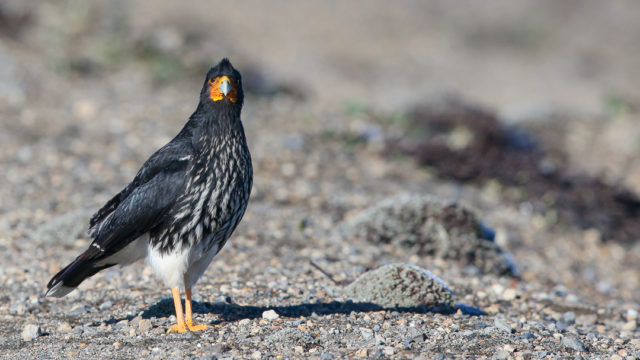
In the afternoon we were able to drive to the highest point vehicles can go, 4,900m (16,000ft). We had been at this altitude before in Chile but Chimborazo was much colder as a strong breeze blew from the mountain’s snowy summit and down its red rocky slopes.
Getting about with heavy camera equipment was a struggle and only very short walks were possible. The pebbly red and white ground crunched as we crossed a frozen moonscape of rock. Snowman high bushes with dark prickly leaves and orange flowers dotted the ground. We were aware of occasional ‘wraith’ like apparitions ‘zip.. zip..zipping’ over our heads. They were hummingbirds, but as they disappeared over the rocks and away, we never managed to see them properly and we hardly cared, we were done in !
We retreated to a warming car and soft seats and drove down to a local village some distance away, our admiration for Humboldt growing by the minute.
The following day dawned sunny and we managed to get to the highest parking area by mid-morning. The summit of the volcano was shrouded by swirling mist, making our hunt for the hummingbird even slower and more deliberate, breathing was difficult and every step felt as if we had bricks tied to our feet.
As on the previous evening, we saw hummingbirds occasionally fly high over our heads, but they disappeared over the moon-like scree slopes.
The reason why this Hillstar is here at all in such an inhospitable environment is due to one plant, the orange flowering shrub Chuquiraga jussieui, one of the national flowers of the Andes, a native to the highlands of Colombia, Ecuador and Peru. It is the flowers of this shrub that provide the nectar, for the enigmatic Hillstar Hummingbird. The bird though, does a much more important task for the plant, transporting its gene laden pollen from one shrub to another. The plants are not common being widely scattered across the landscape so to chance pollination to the wind is too risky a strategy, enticing a efficient servant to do the job for it is much safer.
We decided the best way for us to see a Hillstar close too was to watch some of the Chuquiraga bushes.
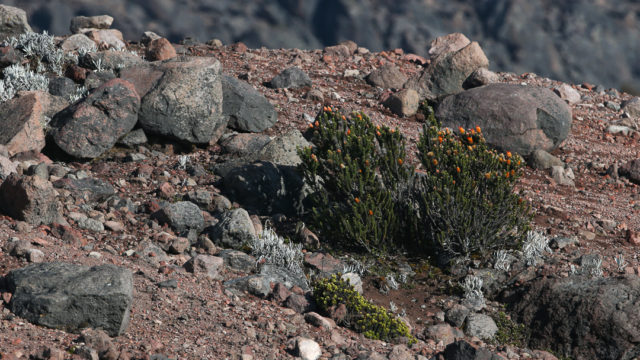
Suddenly one shot into the air from over a ridge but again disappeared. Puzzled, we continued our vigil, hands and cheeks becoming more numb by the minute. The bird re-appeared and settled down again in view on the ground in the lee of a bush. The reason we had been unable to find the birds was because they were going onto the ground, seeking shelter.
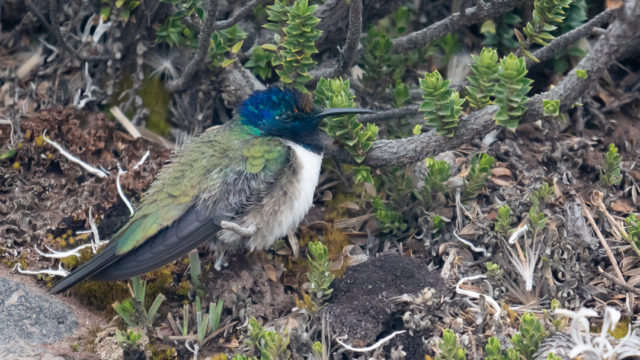
Another bird appeared and darted behind a rock, I slowly edged forward and peeked behind and it immediately flew off. Putting my cold hand where the bird had been sitting, I felt a slight warmth radiating from the rock, heated by the sun during the morning.
Like us, the birds were desperate to keep warm, this was their and our limit of endurance.
